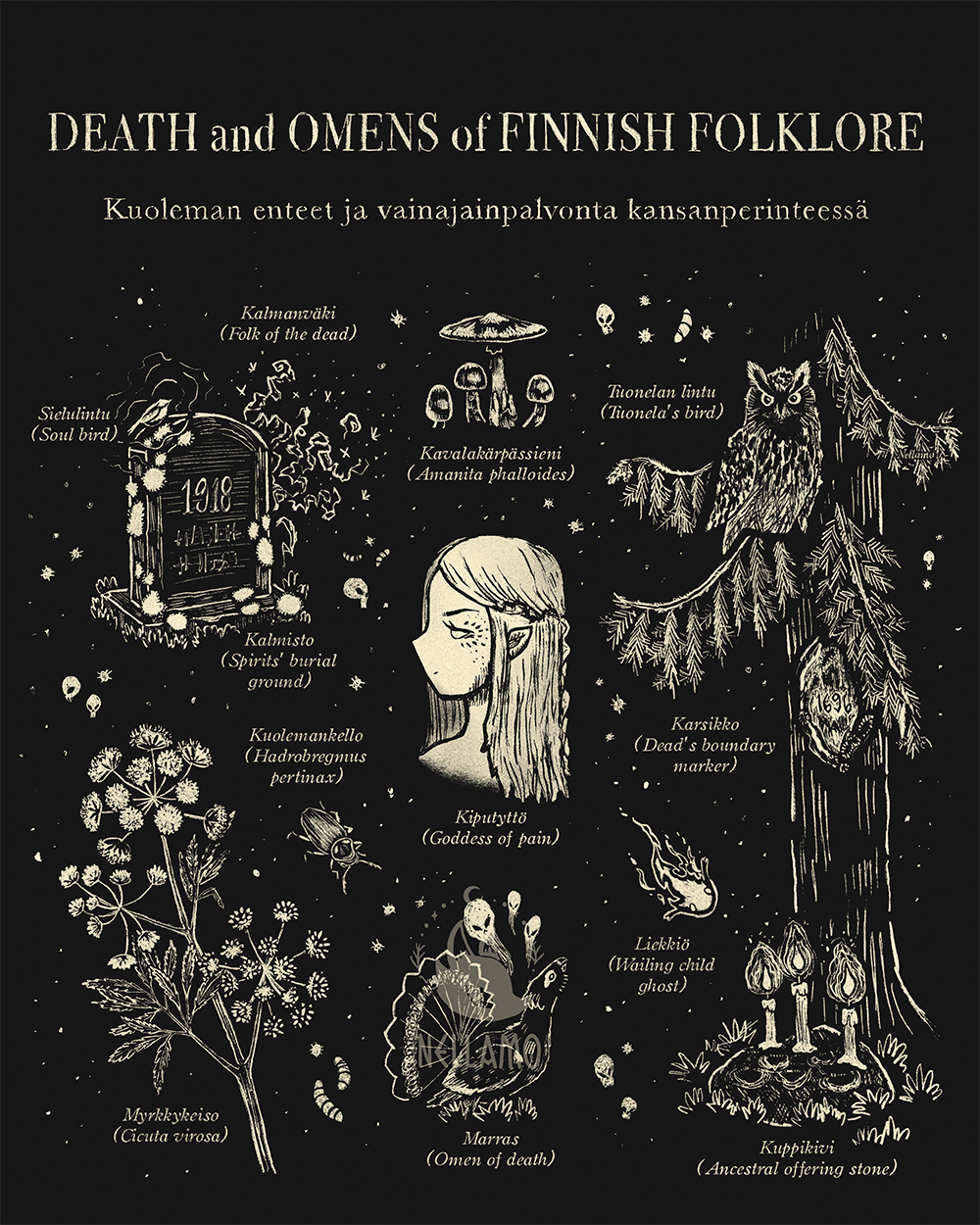
Death and Omens of Finnish Folklore
Share

Death and Omens of Finnish Folklore (2025) Nellamo
The air is slowly getting crisper here in Finland. Rowan trees are laden with intense orange berries that are waiting for their leaves to turn into bright autumn hues.
While in the mood for all things autumnal, I started to gather a list of things related to death and ominous phenomena of Finnish folklore. Don’t get me wrong, I love all things cute and cuddly, but in my heart, I possess a wistful spirit that pines and, somewhat joyfully, aches for the gloomy darkness.
 Death and Omens of Finnish Folklore (2025) Nellamo
Death and Omens of Finnish Folklore (2025) Nellamo
Kiputyttö, "pain girl", the goddess of pain, was a creature said to sit on Kipumäki or Kipuvuori (= the hill of pain/mountain), who received the pains and aches that were cast out of people.
 Death and Omens of Finnish Folklore (2025) Nellamo
Death and Omens of Finnish Folklore (2025) Nellamo
Tuonela's bird, or Eurasian eagle-owl (Bubo bubo), this nocturnal owl's hooting in the dead of night scared people since it was believed that the call was an omen of accidents or even death.
 Death and Omens of Finnish Folklore (2025) Nellamo
Death and Omens of Finnish Folklore (2025) Nellamo
A "karsikko," a mark made on a forest tree, had various meanings. One belief was that these marks were made in honor of a person who had died, placed between their home and their burial site.
The markings on the tree reminded the deceased's spirit that it no longer belonged to the world of the living. This way, the departed would not return to haunt their former home, but would instead find its way to its final resting place.
 Death and Omens of Finnish Folklore (2025) Nellamo
Death and Omens of Finnish Folklore (2025) Nellamo
The Marras was an omen of death or misfortune, appearing in the form of a wild animal that crossed the border between wilderness and a homestead. Its entry into the home's interior was a sure sign of someone's impending death.
In my new artwork, Death and Omens of Finnish Folklore (2025), you can find deadly things and murky omens.
This piece will be featured as a t-shirt, for those who yearn for darker stories and ancestral connections 🍁
The phenomena, creatures, omens and figures appearing in my artwork appear at least in the Finnish, often also in the Karelian folklore as well.
For example, Kiputyttö is also mentioned in this excerpt from the 45th poem from the Kalevala, the Finnish-Karelian epic:
“...Torture-daughter of Tuoni,
Sitting on the mount of anguish,
At the junction of three rivers,
Turning rocks of pain and torture,
Turn away these fell diseases
Through the virtues of the blue-stone;
Lead them to the water-channels,
Sink them in the deeps of ocean,
Where the winds can never find them,
Where the sunlight never enters."
“Should this prayer prove unavailing,
O, Health-virgin, maid of beauty
Come and heal my dying people,
Still their agonies and anguish,
Give them consciousness and comfort,
Give them healthful rest and slumber;"
"These diseases take and banish,
Take them in thy copper vessel,
To thy caves within the mountains,
To the summit of the Pain-rock,
Hurl them to thy boiling caldrons."
"In the mountain is a touch-stone,
Lucky-stone of ancient story,
With a hole bored through the centre,
Through this pour these pains and tortures,
Wretched feelings, thoughts of evil,
Human ailments, days unlucky,
Tribulations, and misfortunes,
That they may not rise at evening,
May not see the light of morning...”
In Finnish:
"...Kiputyttö, Tuonen neiti, joka istut kipukivellä
joen kolmen juoksevassa, veen kolmen jaka'imessa
jauhaen kipukiveä, Kipuvuorta väännätellen!
Käy kivut kereämähän kitahan kiven sinisen,
tahi vieretä vetehen, syytäise meren syvähän,
tuulen tuntumattomahan, päivän paistamattomahan!
"Kun ei tuosta kyllin liene, Kivutar, hyvä emäntä,
Vammatar, valio vaimo, tule kanssa, käy keralla
tekemähän terveyttä, rauhoa rakentamahan!
Tee kivut kivuttomaksi, vammat värjymättömäksi,
jotta saisi sairas maata, huono huoletta levätä,
tuskahinen tunnin olla, vikahinen vieretellä!
"Ota kivut kippasehen, vaivat vaskivakkasehen,
kivut tuonne vieäksesi, vammat vaivutellaksesi
keskelle Kipumäkeä, Kipuvuoren kukkulata!
Siellä keittäös kipuja pikkuisessa kattilassa,
yhen sormen mentävässä, peukalon mahuttavassa!
"Kivi on keskellä mäkeä, reikä keskellä kiveä,
jok' on väätty vääntiällä, puhkaistu purasimella:
siihen kivut kiskotahan, pahat vammat vallatahan,
tuskat tuimat tungetahan, pakkopäivät painetahan
öin yrittämättömiksi, päivin pääsemättömiksi..."
───⊱⌘⊰───
References appearing in the artwork:
- Haavio, Martti 2020. Suomalainen mytologia. Helsinki: Suomalaisen Kirjallisuuden Seura.
- Harva, Uno 2019. Suomalaisten muinaisusko. Helsinki: Suomalaisen Kirjallisuuden Seura.
- Pajari, Ilona, Jalonen, Jussi, Miettinen, Riikka, Kanerva, Kirsi (toim.) 2019. Suomalaisen kuoleman historia. Tallinna: Gaudeamus.
- Pulkkinen, Risto, Lindfors, Stina 2016. Suomalaisen kansanuskon sanakirja. Tallinna: Gaudeamus.
